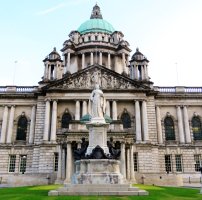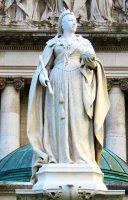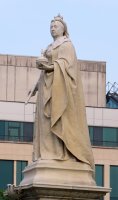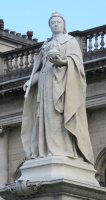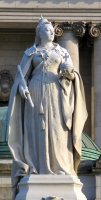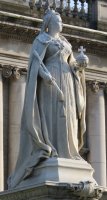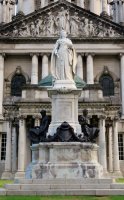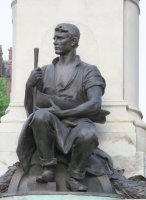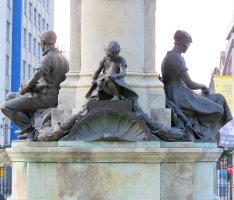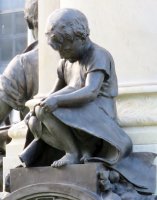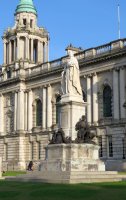Queen Victoria statue, Belfast
Belfast’s Queen Victoria statue, in front of City Hall, is an important work by sculptor Thomas Brock, winning him the commission for the national Victoria Memorial by Buckingham Palace. The Belfast statue also has allegorical seated figures emblematic of textile and ship manufacture.
The grand statue of Queen Victoria stands directly in front of Belfast City Hall, framed by the vast building behind. In the past, the statue was sometimes a source of contention between communities, but today, over a century later, everyone can appreciate and cherish it as the splendid work of art it is. She stands, head turned somewhat to the viewer’s right, gazing into the middle distance; holding orb and sceptre, wearing a sleeved jacket, long skirts down to the ground, and a cloak of heavy material with broad collar, caught up over her arm and hanging in drop-folds. The Queen is shown in middle age, already with her familiar rather broad face, hair tight to the scalp, rather severe mouth, and somewhat heavily lidded eyes. Thomas Brock was the sculptor.
Different aspects of the statue (click to enlarge).
Our Belfast statue was associated with the development and growth of Belfast to become the most successful and populous city on the whole island, bigger than Dublin; it was this same prosperity that led to the building of the new City Hall behind – but that was not completed until a couple of years after the Queen Victoria statue was unveiled. Indeed, at one time it was mooted that the statue should be emplaced at Queen’s University (where there is however an excellent War Memorial, also by Brock - see this page).
Textile manufacture and Shipbuilding.
The statue of the Queen, 11ft high, stands on a tall rectangular plinth, itself on a broader, stepped structure bearing bronze sculpture. As we look at the memorial from in front, to our left is a seated girl dressed in simple, workmanlike clothing, her blouse tied at the front, with short rolled-up sleeves, and with a bulky dress more akin to drapery than clothing. She wears a cap to constrain her hair, so we can see her full neck, quite muscular, as are her arms, and we have a sense of a strong rather than delicate young woman. In one hand she holds a spindle, for she represents the Linen industry and Textile industry more generally, which was so important to the growth of Belfast at that time. To the viewer’s right we have a male figure, a craggy but fairly youthful figure, very muscular in the arm, dressed in workman’s clothes with a smock, and wearing short boots over the ends of his trouser legs. He cradles an ocean line in the crook of one arm, and the long shaft of a hammer in the other, and represents Shipbuilding of course.
Reading (rear of monument).
In front of the figure is a shield, bearing the date 1897, thus a commemoration of the Queen’s jubilee year, with festoons of berries and leaves, also in bronze. And at the rear, thus facing towards the City Hall portico, we have a small child reading from a scroll, emblematic of Education of course, with festoons to the sides and a shell beneath.
The statue was unveiled in 1903, on the occasion of Edward VII’s first visit to Belfast, but closely follows the design of Brock’s first statue of Queen Victoria, in the town where he was born, Worcester, dating from 1887, over two decades earlier (see this page for picture). However it was the likeness, presence and grandeur of this Belfast version which led to the sculptor, Thomas Brock, receiving the commission for the national Queen Victoria Memorial in front of Buckingham Palace. So this Belfast piece really is an important one, as well as an excellent piece of figure sculpture by a foremost portrait sculptor of his time. The subsidiary allegorical figures are typical too of Brock’s style for ideal figures. Brock is also the sculptor for the nearby Edward Harland statue as another example of his portrait sculpture, and the excellent Titanic memorial, with further ideal sculpture.
For See also Statue of Prince Albert, and his clock, and main page on Belfast sculpture and sculptors.
